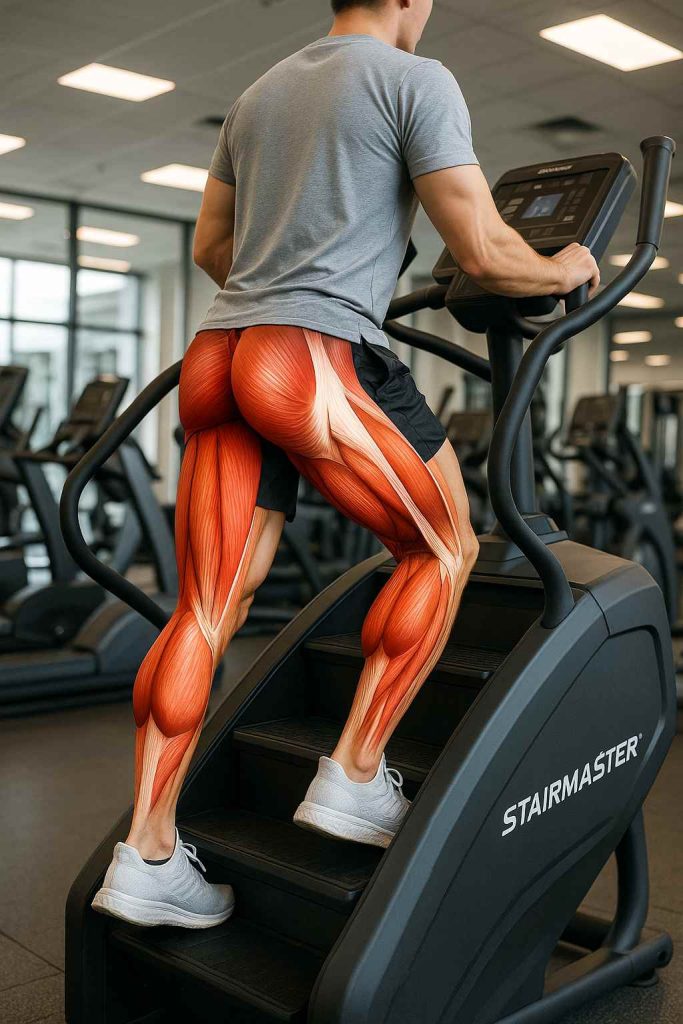The StairMaster works your glutes, quads, hamstrings, calves, and core—making it one of the most effective cardio machines for full lower-body and core engagement. Using a StairMaster isn’t just great for burning calories; it also targets key muscle groups and improves your overall strength, balance, and posture. If you want a workout that tones your legs, lifts your glutes, and boosts your cardiovascular health, the StairMaster delivers—fast.
StairMaster workouts are simple, scalable, and joint-friendly, which makes them a favorite for everyone from beginners to pro athletes. Below, we break down exactly which muscles the StairMaster works, what results you can expect, and how to maximize your benefits with up-to-date tips, stats, and answers to common questions.

For official information on StairMaster machines and safety guidelines, visit the StairMaster official site or your gym’s support page.
What Muscles Does the StairMaster Work?
Glutes, Quads, Hamstrings, and Calves
- Glutes: The stepping motion powerfully targets your gluteus maximus, helping to lift and shape your backside.
- Quadriceps: The front of your thighs is highly activated with each push, especially if you keep an upright posture.
- Hamstrings: The muscles at the back of your thighs work to stabilize and control your steps.
- Calves: Each step forces your calves to engage for balance and lift.
Pro Tip: To intensify glute and hamstring activation, push through your heels rather than your toes (Steel Supplements, 2024).
Core and Hip Flexors: More Than Just Legs
The StairMaster also works your core—including your abdominals, obliques, and lower back—because you must maintain stability and posture while stepping. Your hip flexors are engaged with every lift of your knee, which helps with hip strength and mobility.
- Why it matters: A strong core improves your balance, posture, and overall athletic performance (Cleveland Clinic, 2024).
StairMaster Benefits Beyond Muscles
Bone and Joint Health
The StairMaster is a weight-bearing exercise, which means it helps increase bone density and supports joint health without the high impact of running or jumping. This is especially beneficial for adults concerned with osteoporosis or joint wear (Healthline, 2024).
High Calorie Burn and Cardio
Expect to burn between 180 and 544 calories per hour depending on your weight, speed, and intensity (Cleveland Clinic, 2024). You’ll also boost your heart rate, lung capacity, and endurance—all in one workout.
Functional Fitness
The balance, coordination, and core stability you develop on the StairMaster directly transfer to daily activities, making stair climbing one of the most functional fitness moves you can do.
Popular Workouts: The Viral 25-7-2 Challenge
A trending workout on TikTok, the “25-7-2” StairMaster routine involves climbing for 25 minutes at level 7, two times per week. Many users report visible changes in lower body tone and endurance in just a few weeks. However, beginners should start slow and focus on good form to avoid injury (The Sun, 2024).
How to Maximize StairMaster Results
- Keep an upright posture; don’t lean on the handrails.
- Push through your heels to target glutes and hamstrings.
- Start with short sessions (10-15 minutes), then build up.
- Use intervals for fat loss and stamina: alternate fast and slow periods.
- Incorporate into strength circuits for a total-body burn.
FAQs: StairMaster Muscles & Workouts
Q: Can the StairMaster build muscle?
A: Yes, especially in the glutes and thighs, but it primarily improves endurance and tone rather than bulk.
Q: Is the StairMaster good for abs?
A: Absolutely! Engaging your core is essential for balance, so you’ll work your abs every session.
Q: Is it safe for knees?
A: Generally, yes—provided you use proper form and avoid locking your knees. It’s lower impact than running.
Q: How often should I use the StairMaster?
A: 2-4 times per week for 15-30 minutes is plenty for most people.
Pricing, Access, and Where to Find a StairMaster
- Gym access: Most commercial gyms in the US include StairMaster machines as part of membership (average: $35–$60/month as of July 2025).
- Home machines: StairMaster machines for home use start at around $1,500 for basic models; commercial models can cost $5,000+ (Garage Gym Reviews, 2025).
- Try before you buy: Many gyms offer free guest passes so you can try the machine first.
Conclusion
The StairMaster works your lower body, core, and cardiovascular system in one efficient workout. It’s ideal for anyone wanting to tone their legs, lift their glutes, and burn calories with minimal joint impact. If you’re ready to level up your fitness, add the StairMaster to your routine—and watch your strength, endurance, and confidence climb!
